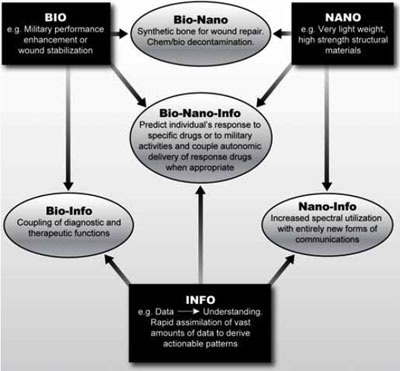| Posted: March 2, 2007 |
Nanotechnology and the Pentagon's 21st century military visions |
|
(Nanowerk News) Last Wednesday, a new report came out from the U.S. Department of Defense (DoD), dryly titled "Defense Science Board 2006 Summer Study on 21st Century Strategic Technology Vectors".
|
|
In what appears to be an even accelerating drive towards "game-changing technology", the U.S. military is looking at the most leading edge technology R&D in universities and laboratories around the world, even some that haven't progressed beyond a vision yet,in order to identify enablers of superior surveillance and weapons technologies.
|
|
The goal of the study was to determine the operational military capabilities to support the national security objectives of the United States in the 21st century. Based on this, the study then identified the science and technology requirements that will support those capabilities and compared it to current science and technology planning as well as transitioning those technologies to a capability. In other words, the Defense Science Board, with a very mission-driven approach, tried to identify promising emerging technologies, such as nanotechnologies, and then recommended not only how to best exploit these technologies for military use, but how to accelerate the move from lab to battlefield.
|
|
The United States Defense Science Board, abbreviated as DSB, is a committee of civilian experts appointed to advise the Department of Defense on Scientific and Technical matters. In their report, they specifically recommends ways that DoD can:
|
|
1) reestablish a tighter integration between DoD's user and technology communities,
|
|
2) enrich its capacity to recognize and exploit technology opportunities,
|
|
3) establish robust processes to insert new capabilities into ongoing operations to meet an expected long term need, and
|
|
4) cut in half the time it normally takes to field major systems.
|
|
The report urges the Pentagon that it must keep abreast of the most rapidly changing and emerging technologies: "Synergistic combinations of these [bio-, info-, nanotechnology] could produce truly revolutionary capabilities in human performance enhancement, medical treatment and prophylaxis, miniaturization, life extension, robotics, and machine intelligence."
|
|
It highlights the use of nanotechnology in R&D programs for clandestine tagging, tracking, and locating: "Nanotechnology, in particular, offers potential for devices that can endure for very long periods of time in close proximity to targets of interest and that can be delivered by clandestine means."
|
|
And further: "A combination of nanotechnology, biology, and chemistry promises to provide significant increases in capability to conduct pervasive surveillance on a global basis."
|
|
The report provides an example of what it terms the "bio-nano-info opportunity space." The rectangles indicate the individual technology area with an example military capability that might be developed using that particular technology. The ovals represent capabilities that derive from the synergy of two or three of these high-rate-of-change technologies:
|
 |
Examples in the Bio-, Nano-, Info Nexus (Defense Science Board)
|
|
The report also encourages more speculative capabilities; "more speculative domains such as ... devices in the micro and nano domains, molecular-scaled taggants, and micro delivery platforms, deserve investment."
|
|
One of our previous Nanowerk Spotlights takes a more detailed look at the U.S. military activities in the nanotechnology area – "Military nanotechnology - how worried should we be?".
|

